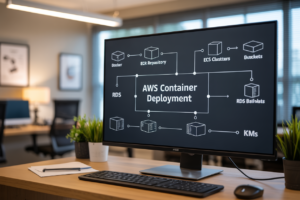Are you drowning in cloud storage costs? 💸 You’re not alone. As businesses increasingly rely on cloud services, managing storage expenses has become a critical challenge. But fear not! There’s a treasure trove of cost optimization strategies waiting to be uncovered in the world of AWS storage services.
From the versatile S3 to the lightning-fast EBS, the flexible EFS to the powerful FSx, and the cost-effective Glacier – each AWS storage solution offers unique opportunities for savings. But here’s the million-dollar question: How can you maximize efficiency while minimizing costs across these diverse storage options? 🤔
In this comprehensive guide, we’ll dive deep into cost optimization strategies for AWS storage services. We’ll explore everything from understanding the nuances of each service to implementing cross-service optimization techniques. Whether you’re looking to streamline your S3 usage, boost EBS efficiency, or make the most of Glacier’s archival capabilities, we’ve got you covered. Get ready to transform your storage spending from a burden into a strategic advantage!
Understanding AWS Storage Services
A. S3: Scalable object storage
Amazon S3 (Simple Storage Service) is a highly scalable object storage service designed for storing and retrieving any amount of data from anywhere on the web. It offers unparalleled durability, availability, and performance, making it ideal for a wide range of use cases.
Key features of S3 include:
- Unlimited storage capacity
- High durability (99.999999999%)
- Flexible storage classes
- Versioning and lifecycle management
- Strong security and access controls
B. EBS: Block-level storage volumes
Amazon Elastic Block Store (EBS) provides persistent block-level storage volumes for use with Amazon EC2 instances. EBS volumes are highly available and reliable storage volumes that can be attached to any running instance in the same Availability Zone.
EBS offers different volume types:
| Volume Type | Use Case | Performance |
|---|---|---|
| General Purpose SSD | Balanced price and performance | Up to 16,000 IOPS |
| Provisioned IOPS SSD | High-performance workloads | Up to 64,000 IOPS |
| Throughput Optimized HDD | Big data and log processing | Up to 500 MB/s |
| Cold HDD | Infrequently accessed workloads | Lowest cost |
C. EFS: Managed file storage for EC2
Amazon Elastic File System (EFS) is a fully managed elastic NFS file system for use with AWS Cloud services and on-premises resources. It’s designed to scale on demand without disrupting applications, growing and shrinking automatically as files are added and removed.
EFS benefits include:
- Shared file storage across multiple EC2 instances
- Automatic scaling without provisioning
- Support for Network File System version 4 (NFSv4) protocol
- Compatibility with Linux-based AMIs for Amazon EC2
D. FSx: Fully managed file systems
Amazon FSx provides fully managed file systems that are built on Windows Server, Lustre, NetApp ONTAP, and OpenZFS. It offers high-performance, feature-rich file storage that’s accessible from Linux, Windows, and macOS compute instances.
FSx options include:
- FSx for Windows File Server
- FSx for Lustre
- FSx for NetApp ONTAP
- FSx for OpenZFS
E. Glacier: Low-cost archival storage
Amazon S3 Glacier is a secure, durable, and extremely low-cost cloud storage service for data archiving and long-term backup. It’s designed to deliver 99.999999999% durability and provides comprehensive security and compliance capabilities.
Glacier storage classes:
- S3 Glacier Instant Retrieval
- S3 Glacier Flexible Retrieval
- S3 Glacier Deep Archive
Now that we’ve covered the fundamentals of AWS storage services, let’s explore how to implement cost optimization strategies for S3.
Implementing S3 Cost Optimization
A. Choosing the right storage class
Selecting the appropriate S3 storage class is crucial for optimizing costs. Consider the following options:
| Storage Class | Use Case | Retrieval Time | Minimum Storage Duration |
|---|---|---|---|
| Standard | Frequently accessed data | Immediate | None |
| Intelligent-Tiering | Unpredictable access patterns | Immediate | None |
| Standard-IA | Infrequently accessed data | Milliseconds | 30 days |
| One Zone-IA | Non-critical, infrequently accessed data | Milliseconds | 30 days |
| Glacier | Long-term archival | Minutes to hours | 90 days |
| Glacier Deep Archive | Rarely accessed archival | Within 12 hours | 180 days |
To optimize costs, analyze your data access patterns and choose the most cost-effective storage class for each dataset.
B. Lifecycle policies for automated transitions
Implement S3 Lifecycle policies to automatically transition objects between storage classes based on predefined rules. This ensures optimal cost management without manual intervention. Key strategies include:
- Move infrequently accessed data to Standard-IA after 30 days
- Transition rarely accessed data to Glacier after 90 days
- Archive old data to Glacier Deep Archive after 180 days
C. Intelligent-Tiering for unpredictable access patterns
For data with changing or unknown access patterns, leverage S3 Intelligent-Tiering. This storage class automatically moves objects between two access tiers based on usage patterns:
- Frequent Access tier
- Infrequent Access tier
Intelligent-Tiering optimizes costs by ensuring that data is stored in the most cost-effective tier without performance impact or operational overhead.
D. Compression and data deduplication techniques
Implement compression and data deduplication to reduce storage costs:
- Use compression algorithms like gzip or bzip2 for compressible data types
- Implement client-side encryption with compression for added security
- Utilize data deduplication techniques to eliminate redundant data
- Consider using S3 Byte-Range Fetches for partial object retrieval
By reducing data volume, you can significantly lower storage costs and improve transfer speeds.
Maximizing EBS Efficiency
Rightsizing EBS volumes
Rightsizing Amazon Elastic Block Store (EBS) volumes is crucial for optimizing costs and performance. Start by analyzing your current usage patterns and identifying underutilized volumes. Use AWS CloudWatch to monitor volume utilization and IOPS consumption.
| Volume Type | Use Case | Cost Efficiency |
|---|---|---|
| gp3 | General purpose | High |
| io2 | High-performance | Medium |
| st1 | Throughput-intensive | Low |
| sc1 | Cold storage | Very low |
- Regularly review and adjust volume sizes based on actual usage
- Consider using thin provisioning to allocate storage on-demand
- Implement automated scaling policies to adjust volume size dynamically
Leveraging EBS snapshots effectively
EBS snapshots are incremental backups that can significantly reduce storage costs when used strategically. Implement a well-planned snapshot lifecycle to balance data protection and cost-efficiency.
Utilizing gp3 volumes for better price-performance
gp3 volumes offer a superior price-performance ratio compared to other EBS volume types. They provide predictable performance with independently provisioned IOPS and throughput.
- Migrate non-critical workloads from io2 to gp3 for cost savings
- Adjust IOPS and throughput settings to match workload requirements
- Use gp3 for boot volumes to reduce costs without sacrificing performance
Implementing automated snapshot management
Automate your snapshot management process to ensure consistent backups and cost control. Use AWS Data Lifecycle Manager or third-party tools to create and manage snapshot schedules.
- Set up retention policies to automatically delete outdated snapshots
- Implement cross-region snapshot copying for disaster recovery
- Use tags to organize and track snapshots for different environments
Now that we’ve covered EBS efficiency, let’s explore how to optimize EFS usage for even greater cost savings and performance improvements.
Optimizing EFS Usage
Selecting appropriate performance modes
Choosing the right performance mode for your Amazon EFS file system is crucial for optimizing costs and performance. EFS offers two performance modes:
- General Purpose
- Max I/O
| Performance Mode | Use Case | Characteristics |
|---|---|---|
| General Purpose | Most applications | Lower latency, higher IOPS |
| Max I/O | Large-scale, parallel workloads | Higher throughput, slightly higher latency |
Select General Purpose mode for most applications, as it provides lower latency and higher IOPS. For large-scale, parallel workloads that require higher throughput, opt for Max I/O mode.
Implementing lifecycle management
Lifecycle management in EFS helps reduce storage costs by automatically moving infrequently accessed files to a lower-cost storage class. Key benefits include:
- Automatic file movement based on access patterns
- Reduced storage costs for rarely accessed data
- Seamless integration with existing applications
To implement lifecycle management:
- Enable lifecycle management in the EFS console
- Set the appropriate transition period (e.g., 30 days)
- Monitor file access patterns and adjust as needed
Using EFS Infrequent Access for cost savings
EFS Infrequent Access (IA) storage class offers significant cost savings for rarely accessed data. Key features:
- Up to 92% lower cost compared to EFS Standard
- Automatic data movement with lifecycle management
- Immediate access when needed
Implement EFS IA by:
- Enabling lifecycle management
- Setting appropriate transition policies
- Monitoring usage and adjusting policies as needed
Monitoring and adjusting provisioned throughput
Proper monitoring and adjustment of provisioned throughput ensure optimal performance and cost-efficiency. Best practices include:
- Use CloudWatch metrics to monitor throughput usage
- Set up alarms for over-provisioning or under-provisioning
- Adjust provisioned throughput based on actual usage patterns
- Consider using Elastic Throughput mode for workloads with varying demands
By following these strategies, you can significantly optimize your EFS usage, balancing performance and cost-effectiveness.
Cost-Effective FSx Strategies
Choosing between FSx for Windows and Lustre
When selecting an FSx solution, consider your specific use case and requirements. Here’s a comparison to help you make an informed decision:
| Feature | FSx for Windows | FSx for Lustre |
|---|---|---|
| Use Case | Windows-based applications | High-performance computing |
| Protocol | SMB | Lustre |
| Performance | Good for general workloads | Extremely high IOPS and throughput |
| Cost | Generally lower | Higher, but justified for performance-intensive workloads |
Choose FSx for Windows for general file sharing and Windows-based applications. Opt for FSx for Lustre when dealing with high-performance computing, machine learning, or big data analytics.
Optimizing storage capacity and throughput
To optimize FSx cost-effectiveness:
- Right-size your storage: Start small and scale up as needed
- Use storage quotas to prevent unexpected growth
- Monitor and adjust throughput capacity based on actual usage
- Leverage data compression to reduce storage requirements
Leveraging data deduplication features
Data deduplication can significantly reduce storage costs, especially for FSx for Windows:
- Enable data deduplication on suitable volumes
- Configure deduplication schedule during off-peak hours
- Monitor deduplication savings and adjust settings as needed
Implementing backup and recovery best practices
Optimize your FSx backup strategy:
- Use automated daily backups
- Implement a retention policy to manage backup costs
- Consider cross-region backups for critical data
- Test recovery procedures regularly to ensure effectiveness
By implementing these strategies, you can significantly reduce costs while maintaining optimal performance and data protection for your FSx deployment. Next, we’ll explore cost management techniques for Amazon Glacier, AWS’s long-term archival storage solution.
Glacier Cost Management
Selecting the right Glacier tier
When optimizing costs for AWS Glacier, choosing the appropriate tier is crucial. Consider the following options:
- Glacier Flexible Retrieval (Standard)
- Glacier Deep Archive
- Glacier Instant Retrieval
| Tier | Retrieval Time | Storage Cost | Retrieval Cost |
|---|---|---|---|
| Flexible Retrieval | 3-5 hours | $0.004/GB/month | $0.01/GB |
| Deep Archive | 12 hours | $0.00099/GB/month | $0.02/GB |
| Instant Retrieval | Milliseconds | $0.01/GB/month | $0.01/GB |
Select the tier based on your data access frequency and urgency requirements.
Optimizing data retrieval strategies
To minimize costs associated with Glacier retrievals:
- Batch retrieval requests
- Use bulk retrieval for large datasets
- Implement a staging area for frequently accessed data
Implementing vault lock policies
Vault lock policies enhance security and compliance:
- Set WORM (Write Once Read Many) policies
- Implement retention periods
- Enforce legal holds
These policies prevent accidental deletions and ensure data integrity.
Leveraging S3 Glacier Instant Retrieval for faster access
For data requiring immediate access:
- Use S3 Glacier Instant Retrieval for millisecond retrieval times
- Ideal for infrequently accessed data that needs immediate availability
- Balance cost with performance needs
With these strategies in place, you can effectively manage Glacier costs while maintaining optimal data accessibility and compliance. Next, we’ll explore cross-service optimization techniques to further enhance your AWS storage cost management.
Cross-Service Optimization Techniques
Data lifecycle management across storage services
Implementing effective data lifecycle management across AWS storage services is crucial for optimizing costs and performance. By strategically moving data between different storage tiers, you can significantly reduce expenses while maintaining accessibility.
Here’s a comparison of AWS storage services and their typical use cases:
| Storage Service | Use Case | Cost |
|---|---|---|
| S3 Standard | Frequently accessed data | $$$ |
| S3 Infrequent Access | Less frequently accessed data | $$ |
| S3 Glacier | Long-term archival | $ |
| EBS | Block storage for EC2 instances | $$$ |
| EFS | Shared file storage | $$$ |
To optimize costs:
- Implement S3 lifecycle policies to automatically transition objects to cheaper storage classes
- Use S3 Intelligent-Tiering for data with unknown or changing access patterns
- Archive infrequently accessed data to Glacier for long-term storage
- Regularly review and delete unnecessary EBS snapshots
- Use EFS Infrequent Access storage class for files accessed less than once a month
Implementing cross-region replication for disaster recovery
Cross-region replication (CRR) is an essential strategy for ensuring data durability and availability. While it incurs additional costs, the benefits often outweigh the expenses in critical scenarios.
Key considerations for CRR:
- Choose target regions strategically to balance cost and latency
- Use S3 Same-Region Replication (SRR) for compliance requirements within a region
- Implement versioning to maintain data integrity during replication
- Consider using S3 Replication Time Control for time-sensitive replications
Utilizing storage gateway for hybrid cloud setups
AWS Storage Gateway provides a seamless bridge between on-premises environments and AWS cloud storage. This hybrid approach can significantly optimize costs and improve performance for organizations transitioning to the cloud.
Storage Gateway offers three main configurations:
- File Gateway: For integrating on-premises file-based applications with S3
- Volume Gateway: For block storage with iSCSI interfaces
- Tape Gateway: For backing up data to S3 and Glacier using existing tape-based processes
By leveraging Storage Gateway, you can:
- Reduce on-premises storage costs
- Implement efficient backup and archival strategies
- Enhance data accessibility and collaboration across hybrid environments
Leveraging AWS Backup for centralized management
AWS Backup provides a centralized solution for managing and automating backups across multiple AWS services. This unified approach can lead to significant cost savings and improved operational efficiency.
Benefits of using AWS Backup:
- Consolidated backup management for various AWS resources
- Automated backup scheduling and retention policies
- Cost-effective long-term retention using cold storage tiers
- Enhanced compliance with centralized backup auditing
Implementing tagging for cost allocation and tracking
Proper tagging is crucial for accurate cost allocation and tracking across AWS storage services. By implementing a comprehensive tagging strategy, you can gain valuable insights into your storage usage and optimize costs accordingly.
Best practices for tagging:
- Develop a consistent tagging nomenclature
- Use automation to ensure all resources are tagged appropriately
- Regularly review and update tags to reflect changing business needs
- Leverage AWS Cost Explorer and AWS Budgets to analyze tagged resources
By implementing these cross-service optimization techniques, you can significantly enhance your AWS storage cost management and efficiency. Remember to regularly review and adjust your strategies as your storage needs evolve.
Effective cost optimization for AWS storage services requires a holistic approach that considers each service’s unique features and pricing models. By implementing strategies such as intelligent data tiering in S3, right-sizing EBS volumes, and leveraging EFS lifecycle management, organizations can significantly reduce their storage costs without compromising performance or data accessibility.
Remember that cost optimization is an ongoing process. Regularly review your storage usage, leverage AWS Cost Explorer and Trusted Advisor, and stay informed about new features and pricing options. By adopting these best practices and continuously refining your storage strategy, you can achieve substantial savings while ensuring your data management needs are met efficiently and cost-effectively in the AWS cloud environment.



















